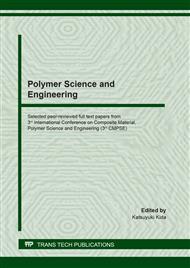p.109
p.116
p.122
p.129
p.140
p.146
p.151
p.157
p.165
Microwave Absorbance of Double-Layer Laminates of Glass Fiber Composite Containing Carbon Black and Carbon Fiber Composite
Abstract:
The microwave absorbing properties of multi-layer carbon/carbon fiber composites, designed to function as radar absorbing structures (RAS), were studied over the X-band frequency range (8.0-12.4 GHz). High-frequency electromagnetic properties of various fibers (glass, carbon) and particulate filler (carbon black) are investigated as the major constituent materials of the RAS. Free space measurement depicts the perfect reflecting properties of carbon fiber composites (S11 = 0 dB, S21 = −40 dB). In the two-layered composite laminate (impedance transformer/reflecting substrate), the use of carbon black is necessary in the impedance transforming layer to obtain the high level of microwave absorbance and frequency tuning. Through the layer combination of the glass-fiber composite (thickness = 2.45 mm) containing carbon black (3% in weight) and carbon fiber composite as reflecting substrate, S11 can be reduced to as low as −40 dB at the frequency of 11.7 GHz, maintaining a low level of S21. The results demonstrate that RAS can be efficiently designed with the laminates of fiber reinforced composites with impedance transforming layer (glass fiber with suitable amount of carbon black) and perfectly reflecting substrate (carbon fiber).
Info:
Periodical:
Pages:
140-145
Citation:
Online since:
August 2020
Authors:
Keywords:
Price:
Сopyright:
© 2020 Trans Tech Publications Ltd. All Rights Reserved
Share:
Citation:


